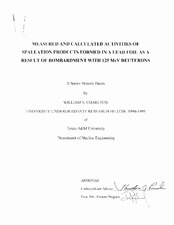| dc.contributor.advisor | Parish, Theodore A. | |
| dc.creator | Charlton, William S. | |
| dc.date.accessioned | 2022-04-01T16:01:57Z | |
| dc.date.available | 2022-04-01T16:01:57Z | |
| dc.date.issued | 1995 | |
| dc.identifier.uri | https://hdl.handle.net/1969.1/CAPSTONE-ParrisP_1982 | |
| dc.description | Program year: 1994/1995 | en |
| dc.description | Digitized from print original stored in HDR | en |
| dc.description.abstract | Current estimates state that approximately 60,000 tons of spent fuel (with burn-ups of 33,000 MW-days/MTU) currently await shipment to the repository at Yucca Mountain, Nevada. This amount is likely to double before the repository's opening. A proposed accelerator-driven transmutation of waste system could lessen the volume and time the waste must be stored in its present state by transmuting the long-lived fission products and "burning" the higher actinides. The transmutations would be caused by exposure of the high-level waste to a high neutron flux produced by spallation reactions in a target material. The spallation reactions would result from the bombardment of the target with high-energy protons or deuterons. While a significant effort has been spent to determine the average neutron yield per incident high energy particle, less effort has been spent to determine the specific radioactive isotopes produced in the target as a result of bombardment.
An experiment conducted at the Texas A&M University Cyclotron consisted of a lead foil that was irradiated with 125 MeV deuterons. The gamma rays from the foil were counted using an efficiency and energy calibrated high-purity germanium detector directly after irradiation. The acquired spectrum revealed many radionuclides were produced as a result of the bombardment. The types of radionuclides and their amounts were determined from the acquired spectrum.
A computer program known as the Los Alamos High Energy Transport code (LAHET) was obtained form Los Alamos National Laboratory. LAHET was used to predict the types and amounts of the radionuclides produced in the lead foil as a result of the irradiation in the TAMU Cyclotron. The measured and calculated activities of the identifiable radionuclides were compared to estimate the accuracy of LAHET. The activities of the short-lived isotopes in the irradiated target is important for the evaluation of dose rates during maintenance and operation of a transmutation system. The activities of the long-lived isotopes produced in the target are important for evaluating disposal options. The amounts of long-lived radioisotopes present in a spallation target after use ought to be at levels such that geologic storage of the target is not necessary. | en |
| dc.format.extent | 64 pages | en |
| dc.format.medium | electronic | en |
| dc.format.mimetype | application/pdf | |
| dc.subject | spent fuel | en |
| dc.subject | transmutation of waste system | en |
| dc.subject | accelerator-driven | en |
| dc.subject | fission products | en |
| dc.subject | actinides | en |
| dc.subject | radioactive isotopes | en |
| dc.subject | radionuclides | en |
| dc.title | Measured And Calculated Activities Of Spallation Products Formed In A Lead Foil As A Result Of Bombardment With 125 MeV Deuterons | en |
| dc.title.alternative | MEASURED AND CALCULATED ACTIVITIES OF SPALLATION PRODUCTS FORMED IN A LEAD FOIL AS A RESULT OF BOMBARDMENT WITH 125 MeV DEUTERONS | en |
| dc.type | Thesis | en |
| thesis.degree.department | Nuclear Engineering | en |
| thesis.degree.grantor | University Undergraduate Research Fellow | en |
| thesis.degree.level | Undergraduate | en |
| dc.type.material | text | en |


